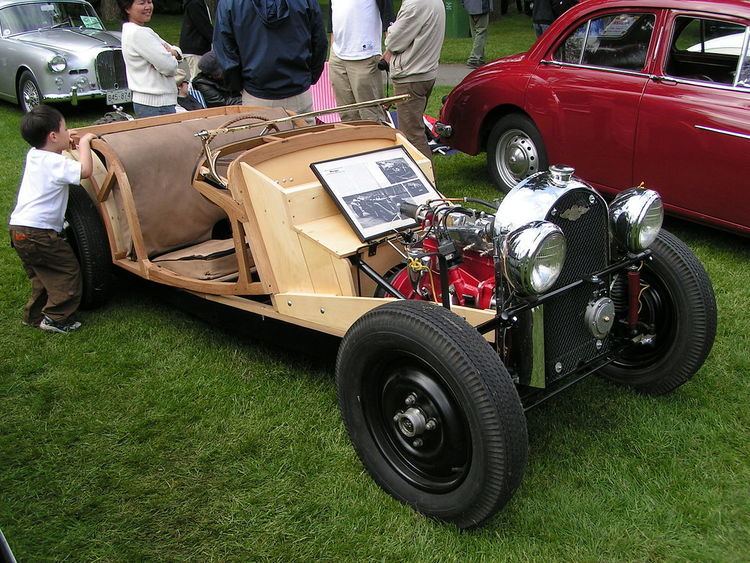 | ||
A coachbuilder is a manufacturer of bodies for automobiles or a manufacturer of complete horse-drawn vehicles.
Contents
- Before automobiles
- Early production
- Ultra luxury vehicles
- Unibody construction
- Belgium
- Czech Republic
- France
- Germany
- Italy
- India
- Japan
- The Netherlands
- Switzerland
- United Kingdom
- United States
- Survivors of the unibody production line system
- References
Coachwork is the body of a motor vehicle (automobile, van, bus, or truck), a horse-drawn coach or carriage (whence the term originated, derived from the Hungarian town of Kocs), or, by extension, a railroad car or railway carriage. The term is usually reserved for bodies built on a separate chassis (body-on-frame construction), rather than being of unibody or monocoque construction. With reference to motor vehicles, auto body is the standard term in North American English. An obsolescent synonym is carrossery (plural: carosseries).
Coachbuilders are: carrossiers in French, carrozzeria in Italian, karosseriebauer in German and carroceros in Spanish.
In reference to a recreational vehicle or motorhome, coach-built means a vehicle which has been purpose-built, using only a chassis as a base vehicle, as opposed to a conversion which is built inside an existing vehicle body.
Before automobiles
A British trade association the Worshipful Company of Coachmakers and Coach Harness Makers, was incorporated in 1630. Some British coachmaking firms operating in the 20th century were established even earlier. Rippon was active in the time of Queen Elizabeth I, Barker founded in 1710 by an officer in Queen Anne's Guards, Brewster a relative newcomer (though oldest in the U.S.), formed in 1810.
Early production
In the early motoring days when series production did not yet exist the process of acquiring a new vehicle needed two major decisions, selection of a vehicle manufacturer and selection of a coachbuilder. Already accustomed to ordering carriages from a coachbuilder, the buyer would select an automobile manufacturer which might supply their own catalogued bodies but which would be expected to provide primarily only a bare "chassis".
This "chassis" would be delivered by the manufacturer to the coachbuilder of the buyer's choice. The "chassis" would be a rolling chassis which included the chassis frame, drivetrain (engine, gearbox, differential, axles, wheels), brakes, suspension, complete steering system including the wheel, radiator, scuttle and dashboard. The manufacturer delivered the chassis with lighting system, spare wheel(s) (but probably without tyres), front and rear mudguards and (later) bumpers. The very easily damaged honeycomb radiator, later enclosed and protected by a shell, became the main visual element identifying the chassis' brand. The manufacturer retained an element of control over bodies. Bodies not approved by the chassis manufacturer would lose the chassis manufacturer's chassis warranties.
Until the second World War it would not have been unusual to order the most popular cars as only a chassis and have a local coachbuilder put a body (passenger or commercial) on it for you. the Austin 7s of the 1920s and 1930s were favourite subjects.
For mass production because the long-established and refined skills and tools (such as the English wheel) used to build the wooden and metal bodies of vehicles were so specialized, most USA automobile manufacturers contracted with existing coachbuilders to produce bodies. For example, Fisher Body built all of Cadillac's closed bodies in the 1910s and eventually all General Motors mass-produced products.
Ultra luxury vehicles
Commonly, larger dealers or distributors of ultra-luxury cars would pre-order stock chassis and the bodies they thought most likely to sell, and stock them in suitable quantities for sale off their showroom floor.
Though automobile manufacturers brought body building skills in-house, the practice of bespoke or custom coachbuilding remained in favour among the wealthy, who continued the habit of centuries past. All ultra-luxury vehicles sold as chassis only. For instance, when Duesenberg introduced their Model J, it was offered as chassis only, for $8,500. Other examples include the Bugatti Type 57, Cadillac V-16, Ferrari 250, Isotta Fraschini Tipo 8, and all Rolls-Royces produced before World War II. Delahaye had no in-house coachworks, so all its chassis were bodied by independents, who created some of their most attractive designs on the Type 135. Most of the Delahayes were bodied by Chapron, Labourdette, Franay, Saoutchik, Figoni & Falaschi, Pennock, and many more.
Unibody construction
The advent of unibody construction, where the car body is unified with, and structurally integral to the chassis, made custom coachbuilding (in the traditional sense of putting a bespoke body on a factory supplied separate chassis) practically impossible. Many coachbuilders closed down, were bought by manufacturers or changed their core business to other activities:
Independent coachbuilders survived for a time after the mid-20th century, making bodies for the chassis produced by low-production companies such as Rolls-Royce, Ferrari, and Bentley. Producing body dies is extremely expensive (a single door die can run to US$40,000), which is usually only considered practical when large numbers are involved—though that was the path taken by Rolls-Royce and Bentley after 1945 for their own in-house production. Because dies for pressing metal panels are so costly, from the mid 20th century, many vehicles, most notably the Chevrolet Corvette, were clothed with large panels of glass-fibre reinforced resin, which only require inexpensive moulds. Glass has since been replaced by more sophisticated materials but generally these replace, if necessary hand-formed, metal only where weight is of paramount importance.
